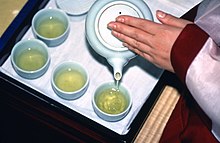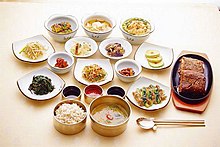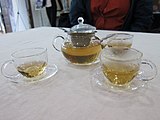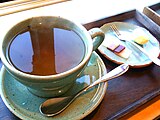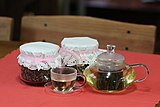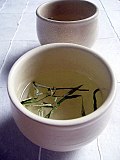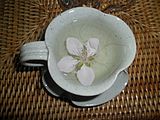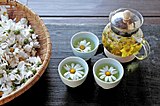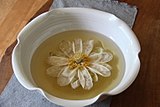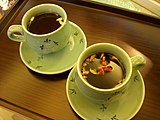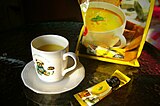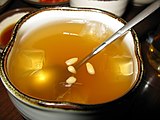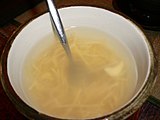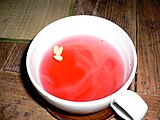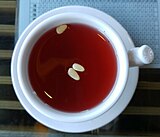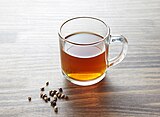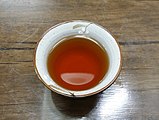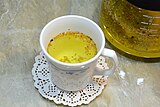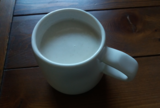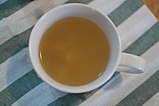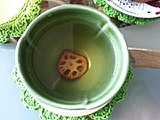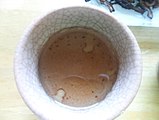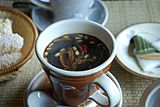|
Korean tea
Korean tea is a beverage consisting of boiled water infused with leaves (such as the tea plant Camellia sinensis), roots, flowers, fruits, grains, edible mushrooms, or seaweed. It may or may not contain tea leaves. History
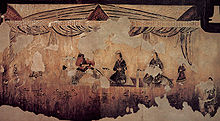 According to the Record of Gaya, cited in the Memorabilia of the Three Kingdoms, the legendary queen Heo Hwang-ok, a princess of the State of "Ayuta" (theorized to be Ayodhya, India), brought the Camellia sinensis (var. assamica) tea plant from India to Korea and planted it on Baegwolsan, a mountain that borders the city of Changwon.[1] In practice, however, Labrador tea and fruit teas, such as magnolia berry tea and goji berry tea, were more widely used in the Samhan Era instead.[2] It is a widely held belief that the systematic planting of tea bushes began with the introduction of tea culture by Buddhist monks some centuries later.[1] Some of the earliest Buddhist temples in Korea, such as Bulgapsa, Bulhoesa, and Hwaeomsa, claim to be the birthplace of Korean tea culture.[1] The import of Chinese tea products started during the reign of Queen Seondeok of Silla (631‒647), when two types of tea bricks, jeoncha (전차; 磚茶) and dancha (단차; 團茶), were imported from the Tang Empire.[2] In 765, a Buddhist monk is said to have presented an offering of the tea to King Gyeongdeok and the Buddha.[2] Camellia sinensis tea plants spread throughout the country in 828, when King Heungdeok received seeds from the Tang Empire and sent them to be planted on the Jirisan mountain.[1] Tea was usually offered to the Buddha, as well as to the spirits of deceased ancestors.[1] Tea culture continued to prosper during the Goryeo Dynasty. Tea offering was a part of the biggest national ceremonies, such as Yeondeunghoe and Palgwanhoe, and tea towns were formed around temples.[2] During the reign of King Myeongjong (1131‒1202), Seon-Buddhist manners of ceremony prevailed. Chŏng Mong-ju and other scholars enjoyed tea poetry, dasi (다시; 茶詩), and tea meetings, dahoe (다회; 茶會).[2] The state of daseonilchi (다선일치; 茶禪一致; "tea and seon in accord") was eulogized.[2] Xu Jing, a Song dynasty envoy who visited Goryeo in 1123, wrote in the Gaoli tujing that the people of Goryeo were avid tea drinkers and set out tea three times a day.[3] Coins were accepted at tea and wine shops (茶酒店).[4] During the Joseon Dynasty (1392–1910), Korean tea culture underwent secularization.[5] The royal family and aristocracy used tea for simple rites, a practice referred to as darye (다례; 茶禮, "tea rite"), which is often translated as "etiquette for tea".[2] Towards the end of the Joseon Dynasty, commoners adopted the practice of using tea for ancestral rites.[6] The word charye (차례; 茶禮, "tea rite"), cognate to darye, now refers to jesa (ancestral rite).[7][8] In the past, the two terms were synonymous, as ancestral rites often involved offerings of tea to the ancestors. Wedding ceremonies also included tea offerings. The practice of packing tea into small cakes, which lost popularity in China during the 14th century, continued in Korea until the 19th century.[1] In 1895, King Gojong of the Korean Empire used coffee for the first time.[2] In 1896, grocery stores began to have tea rooms as annexes, and the first modern tea house was established in 1924.[2] TraditionsThe Korean Tea Ceremony, called Darye, embodies Confucian principles of harmony, respect, and gratitude. It occurs in a traditional Korean house, with participants wearing hanbok attire. Darye involves tea preparation, serving, and presentation. The host serves tea to guests in order of importance, using a ceramic teapot and small cups. It is believed that Darye fosters a peaceful ambiance for appreciating tea's beauty, meaningful conversations, and reflection on respect and gratitude.[9] MarketAlthough tea from the Camellia sinensis plant is not as popular as coffee in South Korea – with the annual South Korean tea consumption at 0.16 kg (0.35 lb) per capita, compared to 3.9 kg (8.6 lb) for coffee[10] – grain teas are served in many restaurants instead of water.[11][12] Herbal and fruit teas are commonly served, both hot and cold.[12] VarietiesFrom Camellia sinensisUnoxidized
Partially oxidized
Oxidized
Post-fermented
Other leaf teas
Flower teas
Fruit teas
Grain, bean, and seed teas
Root, shoot, and bark teas
Combination and other teas
See alsoReferences
|
|||||||||||||||||||||||||||||||||||||||||||||||||||||||||||||||||||||||||||||||||||||||||||||||||||||||||||||||||||||||||||||||||||||||||||||||||||||||||||||||||||||||||||||||||||||||||||||||||||||||||||||||||||||||||||||||||||||||||||||||||||||||||||||||||||||||||||||||||||||||||||||||||||||||||||||||||||||||||||||||||
